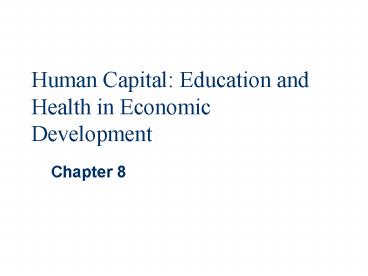Human Capital: Education and Health in Economic Development - PowerPoint PPT Presentation
1 / 13
Title:
Human Capital: Education and Health in Economic Development
Description:
Age-earnings profiles by education level in Venezuela ... Adult Mortality in Poor and Nonpoor Neighborhoods of Porto Alegre, Brazil, 1980 ... – PowerPoint PPT presentation
Number of Views:2240
Avg rating:3.0/5.0
Title: Human Capital: Education and Health in Economic Development
1
Human Capital Education and Health in Economic
Development
- Chapter 8
2
Human Capital Investments in Health and
Education Raise Incomes and Well-Being
Age-earnings profiles by education level in
Venezuela
3
Wealth and Health Infant and Adult Mortality in
Poor and Nonpoor Neighborhoods of Porto Alegre,
Brazil, 1980
4
Height as a Proxy for Health
5
Wages, Education, and Height of Males in Brazil
and the United States
6
Education and Health as Investments
Invest in Ed if NPV of higher earnings net of
costs is positive (note importance of capital
markets, ability to self-finance)
7
Private versus Social Benefits and Costs of
Education
8
(No Transcript)
9
The Gender Gap Women and Education
- Young females receive less education than young
males in nearly every LDC - Benefits of closing this educational gender gap
(why?) - Lower fertility
- Higher child health and survival
- Quality of life
10
(No Transcript)
11
Effects of Male Bias Female-Male Ratios in Total
Population in Selected Communities
12
Educational opportunity and Economic Growth
Lorenz curves for India and Korea, 1990
13
Economic Growth and Income Inequality A Human
Capital Approach
- Use 2-sector model with low-skilled (illiterate)
and high-skilled (literate) labor to explain
facts about growth, labor migration and income
distribution - Higher poverty in rural areas
- High rates of labor migration
- Persistent unemployment or under-employment in
urban areas































